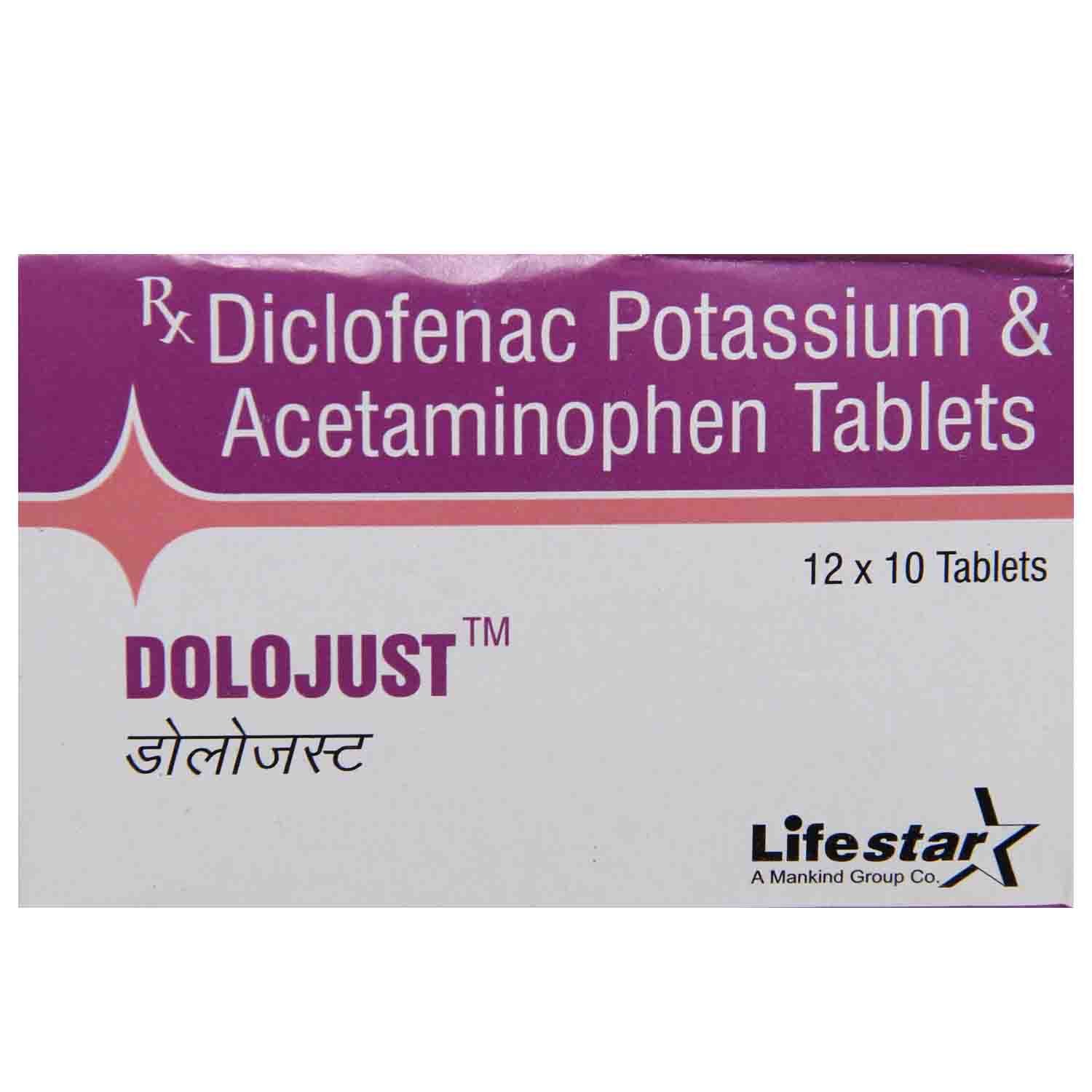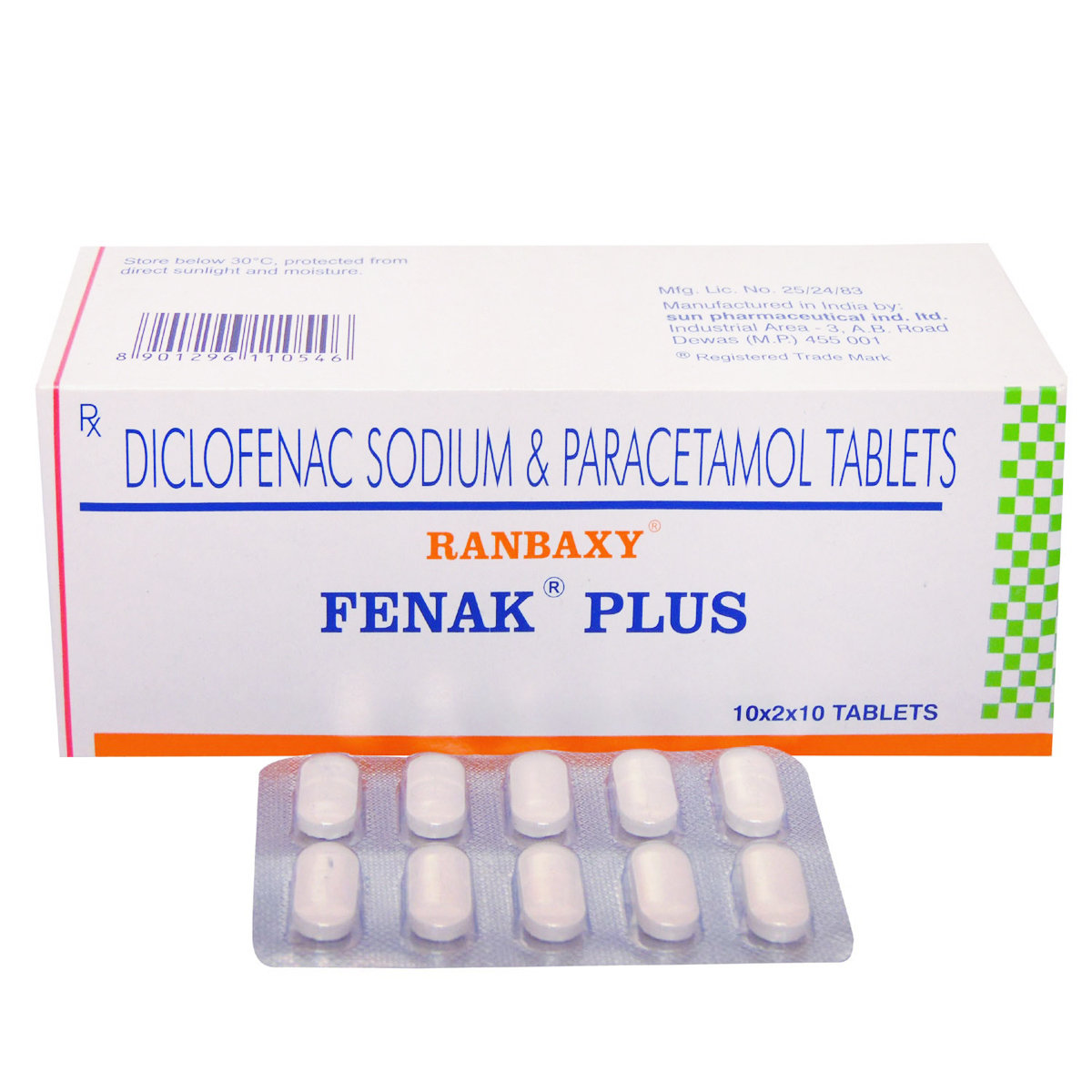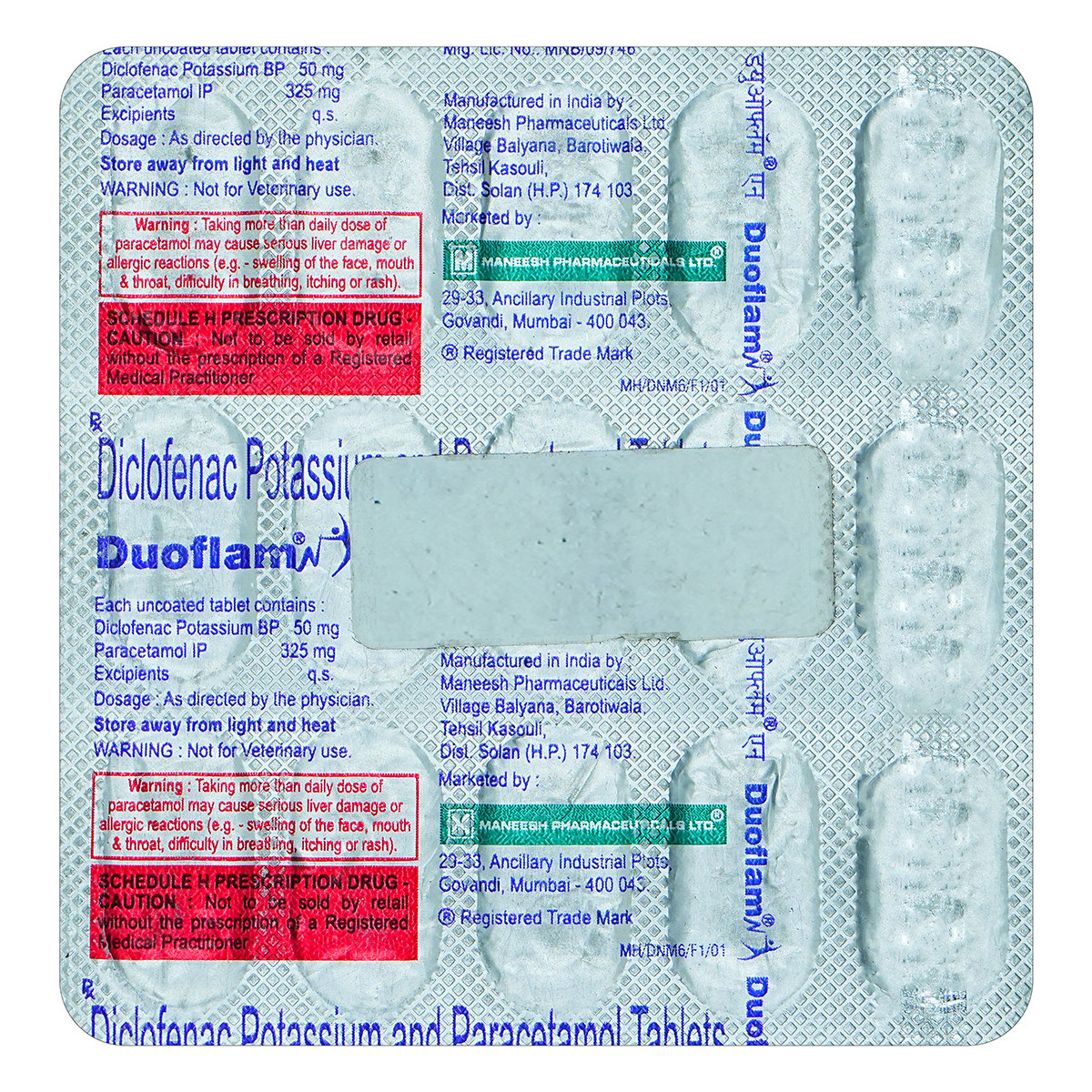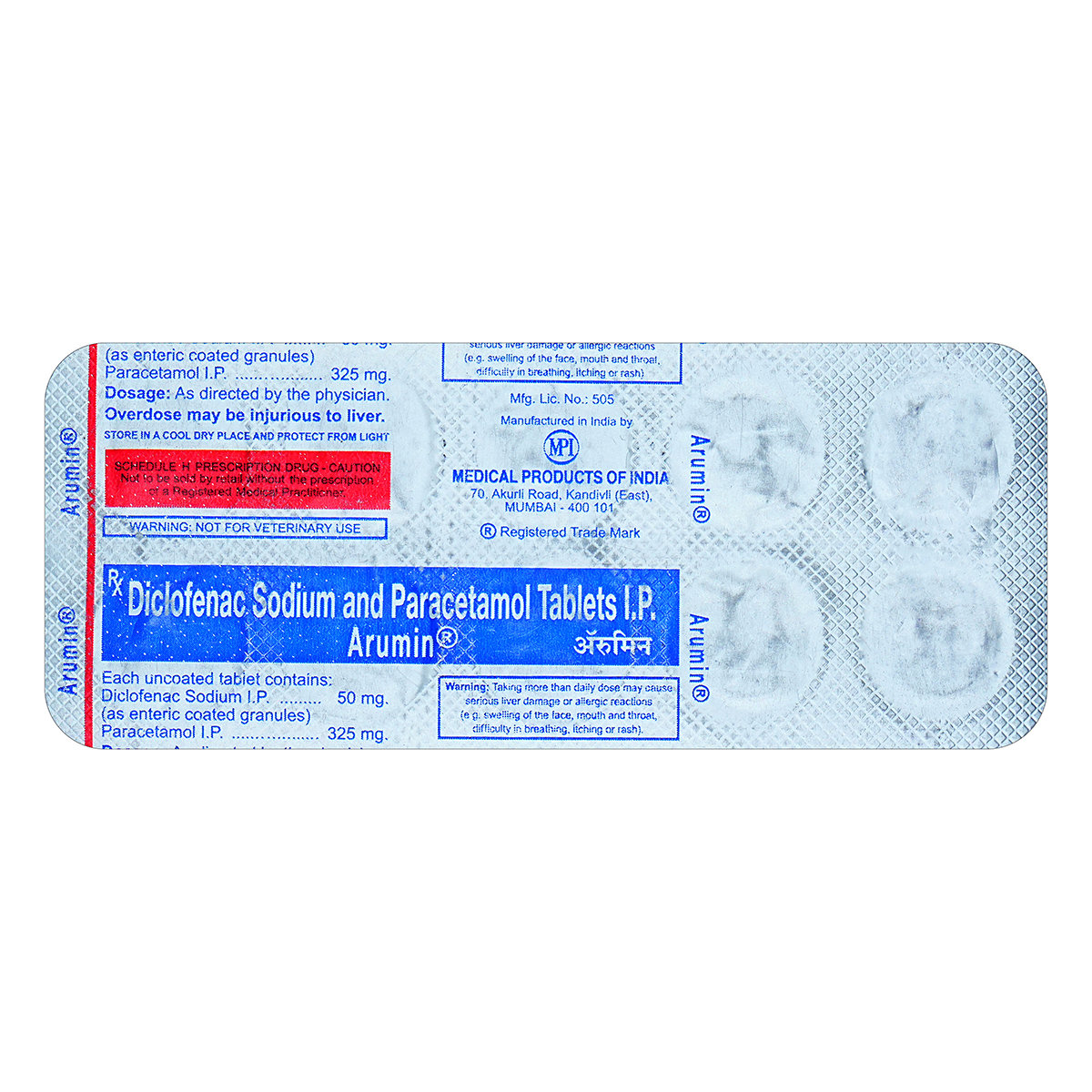Dicon Plus 50 mg/500 mg Tablet


MRP ₹15
(Inclusive of all Taxes)
₹2.3 Cashback (15%)
Provide Delivery Location
Online payment accepted
 Prescription drug
Prescription drugWhats That
Composition :
Manufacturer/Marketer :
Consume Type :
Return Policy :
About Dicon Plus 50 mg/500 mg Tablet
Dicon Plus 50 mg/500 mg Tablet belongs to a class of medications known as a non-steroidal anti-inflammatory drug (NSAID) or pain killer. Dicon Plus 50 mg/500 mg Tablet is widely useful for treating painful musculoskeletal joint conditions like osteoarthritis, rheumatoid arthritis and ankylosing spondylitis.
Dicon Plus 50 mg/500 mg Tablet contains Diclofenac (analgesic) and Paracetamol (fever reducer/mild analgesic), effective against painful musculoskeletal pain, joint pain, and skeletal muscle spasms. Diclofenac works by blocking the action of a chemical messenger known as cyclo-oxygenase (COX), which causes pain and swelling at the injured or damaged tissue site. On the other hand, paracetamol acts as a mild analgesic (mild pain reducer) and antipyretic (fever reducer), enhancing Diclofenac's pain relief action. It also helps relieve toothache, ear pain, backache and other musculoskeletal-related pain.
Dicon Plus 50 mg/500 mg Tablet can be taken with or after the meal. Dicon Plus 50 mg/500 mg Tablet may cause common side effects like stomach upset, dizziness, light-headedness, malaise, nausea, vomiting, liver dysfunction (hepatitis), pruritis (itchy skin), and rash, although not everybody gets them. Most of these side effects do not require medical attention and will resolve gradually. However, you are advised to talk to your doctor if the side effects persist or worsen.
Dicon Plus 50 mg/500 mg Tablet is not recommended during the last three months of pregnancy and for children. Inform your doctor if you are pregnant or breastfeeding before receiving this injection. Keep your doctor informed about your health condition and ongoing medicines to rule out any side effects/interactions. Stop taking this medicine if you experience symptoms like tightness of the chest, breathing difficulties, fever, skin rashes, increased heart rate, and or in case of any signs of hypersensitivity.
Uses of Dicon Plus 50 mg/500 mg Tablet
Directions for Use
Medicinal Benefits
Dicon Plus 50 mg/500 mg Tablet contains Diclofenac (analgesic) and Paracetamol (fever reducer/mild analgesic), effective against painful musculoskeletal pain, joint pain, and skeletal muscle spasms. Diclofenac works by blocking the action of a chemical messenger known as cyclo-oxygenase (COX), which causes pain and swelling at the injured or damaged tissue site. On the other hand, paracetamol acts as a mild analgesic (mild pain reducer) and antipyretic (fever reducer), enhancing Diclofenac's pain relief action. It also helps relieve toothache, ear pain, backache and other musculoskeletal-related pain.
Storage
- Drink water or other clear fluids.
- To prevent worsening of pain, limit intake of tea, coffee, or alcohol.
- Include bland foods like rice, toast, crackers, and rice in your diet.
- Avoid lying down immediately after eating as it may cause indigestion or heartburn.
- Avoid acidic and spicy food as it may cause indigestion.
- Inform your doctor about your constipation symptoms. They may adjust your medication or advise alternative treatments.
- Stay hydrated by drinking sufficient of water (at least 8-10 glasses a day) to help soften stool and promote bowel movements.
- Increase fibre intake by eating foods high in fibre, such as fruits, whole grains, vegetables and legumes, to help bulk up the stool.
- Establish a bowel routine by trying to go to the bathroom at the same time each day to train your bowels.
- Engaging in regular exercise, like walking or yoga, can support in bowel movement stimulation.
- Consult your doctor if constipation persists, and discuss alternative treatments or adjustments to your medication.
- Inform Your Doctor: Notify your doctor immediately about your diarrhoea symptoms. This allows them to adjust your medication or provide guidance on managing side effects.
- Stay Hydrated: Drink plenty of fluids to replace lost water and electrolytes. Choose water, clear broth, and electrolyte-rich drinks. Avoid carbonated or caffeinated beverages to effectively rehydrate your body.
- Follow a Bland Diet: Eat easy-to-digest foods to help firm up your stool and settle your stomach. Try incorporating bananas, rice, applesauce, toast, plain crackers, and boiled vegetables into your diet.
- Avoid Trigger Foods: Steer clear of foods that can worsen diarrhoea, such as spicy, fatty, or greasy foods, high-fibre foods, and dairy products (especially if you're lactose intolerant).
- Practice Good Hygiene: Maintain good hygiene to prevent the spread of infection. To stay healthy, wash your hands frequently, clean and disinfect surfaces regularly, and avoid exchanging personal belongings with others.
- Take Anti-Diarrheal Medications: If your doctor advises, anti-diarrheal medications such as loperamide might help manage diarrhoea symptoms. Always follow your doctor's directions.
- Keep track of your diarrhoea symptoms. If they don't get better or worse or are accompanied by severe stomach pain, blood, or dehydration signs (like extreme thirst or dark urine), seek medical help.
- Take medications with food (if recommended): It can help prevent stomach distress and indigestion.
- Eat smaller, more frequent meals: Divide daily food intake into smaller, more frequent meals to ease digestion.
- Avoid trigger foods: Identify and avoid foods that trigger indigestion, such as spicy, fatty, or acidic foods.
- Stay upright after eating: Sit or stand upright for at least 1-2 hours after eating to prevent stomach acid from flowing into the oesophagus.
- Avoid carbonated drinks: Avoid drinking carbonated beverages, such as soda or beer, which can worsen indigestion.
- Manage stress: To alleviate indigestion, engage in stress-reducing activities like deep breathing exercises or meditation.
- Consult a doctor if needed: If indigestion worsens or persists, consult a healthcare professional to adjust the medication regimen or explore alternative treatments.
- Tell your doctor about your GAS symptoms. They may change your medication regimen or prescribe additional drugs to help you manage them.
- To manage GAS symptoms, eat a balanced diet of fibre, vegetables, and fruits.
- Drink enough water throughout the day to avoid constipation and treat GAS symptoms.
- Regular exercise like yoga and walking may help stimulate digestion and alleviate GAS symptoms.
- Take probiotics only if your doctor advises, as they may help alleviate GAS symptoms by promoting gut health.
- Take medication for GAS symptoms only if your doctor advises, as certain medications can interact with your existing prescriptions or worsen symptoms.
- If symptoms persist, worsen, or are accompanied by severe abdominal pain, vomiting, or bleeding, seek immediate medical attention.
- Inform your doctor about the nausea and discuss possible alternatives to the medication or adjustments to the dosage.
- Divide your daily food intake into smaller, more frequent meals to reduce nausea.
- Opt for bland, easily digestible foods like crackers, toast, plain rice, bananas, and applesauce.
- Avoid certain foods that can trigger nausea, such as fatty, greasy, spicy, and smelly foods.
- Drink plenty of fluids, such as water, clear broth, or electrolyte-rich beverages like coconut water or sports drinks.
- Use ginger (tea, ale, or candies) to help relieve nausea.
- Get adequate rest and also avoid strenuous activities that can worsen nausea.
- Talk to your doctor about taking anti-nausea medication if your nausea is severe.
- Record when your nausea occurs, what triggers it, and what provides relief to help you identify patterns and manage your symptoms more effectively.
Drug Warnings
Do not take Dicon Plus 50 mg/500 mg Tablet if you are allergic to any components present in it. Patients with asthma, prolonged bleeding time, wheezing (whistling sound during breath), and blocked airways (bronchospasm) should avoid using Dicon Plus 50 mg/500 mg Tablet. It is not recommended for use in children less than 14 years of age, people with liver disease, heart disease, or gastric ulcers/bleeding problems. Dicon Plus 50 mg/500 mg Tablet may be associated with a small increase in the risk of heart attack (myocardial infarction). Pregnant women should not take during their last trimester of pregnancy. Dicon Plus 50 mg/500 mg Tablet is excreted in the breast milk, so the nursing mother should contact the doctor before its usage. Avoid the consumption of alcohol as it may damage your liver and cause even more side effects on taking this drug. Consult your doctor if your pain, inflammation, and fever symptoms do not disappear even after ten days.
Drug-Drug Interactions
Drug-Drug Interactions
Login/Sign Up
Co-administration of Dicon Plus 50 mg/500 mg Tablet with Meloxicam can increase the risk or severity of gastrointestinal side effects.
How to manage the interaction:
Taking Meloxicam with Dicon Plus 50 mg/500 mg Tablet is not recommended as it can possibly result in an interaction, it can be taken if your doctor has advised it. However, consult your doctor immediately if you experience symptoms such as dizziness, lightheadedness, red or black, tarry stools, coughing up or vomiting fresh or dried blood that looks like coffee grounds, severe headache, and weakness. Do not stop any medication without doctor's advise.
Co-administration of Dicon Plus 50 mg/500 mg Tablet may decrease the excretion rate of Oxazepam which could result in a higher serum level.
How to manage the interaction:
Although there is a possible interaction between Oxazepam and Dicon Plus 50 mg/500 mg Tablet, you can take these medicines together if prescribed by a doctor. Do not stop using any medications without a doctor's advice.
Co-administration of ketamine and Dicon Plus 50 mg/500 mg Tablet may decrease the effectiveness of Ketamine which could result in a higher blood level.
How to manage the interaction:
Although taking Ketamine and Dicon Plus 50 mg/500 mg Tablet together can evidently cause an interaction, it can be taken if a doctor has suggested it. If you're feeling very sleepy or having trouble breathing, it's important to contact your doctor right away. Do not stop using any medications without a doctor's advice.
Co-administration of Teriflunomide with Dicon Plus 50 mg/500 mg Tablet may increase the risk or severity of Liver problems.
How to manage the interaction:
Taking Dicon Plus 50 mg/500 mg Tablet with Teriflunomide together can possibly result in an interaction, but it can be taken if a doctor has advised it. Do not discontinue any medications without consulting a doctor.
Co-administration of Dicon Plus 50 mg/500 mg Tablet and Ketoconazole may increase the risk of liver injury.
How to manage the interaction:
Although there is a possible interaction between Dicon Plus 50 mg/500 mg Tablet and Ketoconazole, you can take these medicines together if prescribed by a doctor. However, if you have joint pain or swelling, fever, chills, unusual bleeding or bruising, skin rash, itching, over-tiredness, nausea, vomiting, loss of appetite, stomach pain, dark-colored urine, light-colored stools, and/or yellowing of the skin or eyes, contact a doctor immediately as these may be signs and symptoms of liver damage. Do not discontinue the medication without consulting a doctor.
Co-administration of Dicon Plus 50 mg/500 mg Tablet and Leflunomide may increase the risk of liver problems.
How to manage the interaction:
Although there is a possible interaction between Dicon Plus 50 mg/500 mg Tablet and Leflunomide, they can be taken together if prescribed by a doctor. However, if you experience fever, chills, joint pain or swelling, unusual bleeding or bruising, skin rash, itching, less desire to eat, fatigue, nausea, vomiting, abdominal pain, or yellowing of the skin or eyes, contact a doctor immediately. Do not discontinue any medications without consulting a doctor.
Co-administration of Dicon Plus 50 mg/500 mg Tablet and Valdecoxib may increase the risk or severity of adverse effects.
How to manage the interaction:
Although there is a possible interaction between Dicon Plus 50 mg/500 mg Tablet and Valdecoxib, you can take these medicines together if prescribed by a doctor. However, if the side effects worsen, please consult a doctor.
Co-administration of Lomitapide and Dicon Plus 50 mg/500 mg Tablet may increase the risk of severity of liver injury.
How to manage the interaction:
Although there is a possible interaction between Dicon Plus 50 mg/500 mg Tablet and Lomitapide, you can take these medicines together if prescribed by a doctor. Do not stop using any medications without a doctor's advice.
Co-administration of Mipomersen with Dicon Plus 50 mg/500 mg Tablet may increase the risk or severity of liver injury.
How to manage the interaction:
There may be a possibility of interaction between Dicon Plus 50 mg/500 mg Tablet and Mipomersen, but it can be taken if prescribed by a doctor. Do not stop using any medications without talking to a doctor.
Taking Dicon Plus 50 mg/500 mg Tablet with Enoxaparin can increase the risk of bleeding complications.
How to manage the interaction:
There may be a possible interaction between Dicon Plus 50 mg/500 mg Tablet and Enoxaparin, but they can be taken together if your doctor has prescribed them. However, consult your doctor immediately if you experience any unusual bleeding or bruising, swelling, vomiting, blood in your urine or stools, headache, dizziness, or weakness. Do not discontinue any medications without consulting a doctor.
Drug-Food Interactions
Drug-Food Interactions
Login/Sign Up
Diet & Lifestyle Advise
- Physical activity helps strengthen muscles and relieves joint stiffness. Gentle exercises like 20-30 minutes of walking or swimming would be helpful.
- Performing yoga may also help in improving joint flexibility and pain management.
- Maintain a healthy weight by performing regular low-strain exercises and eating healthy food.
- Get adequate sleep, as resting the muscles can help reduce inflammation and swelling.
- Follow heat or cold therapy, and apply a cold or hot compress on the joints for 15-20 minutes regularly.
- De-stress yourself by meditating, reading books, taking a warm bubble bath or listening to soothing music.
- Acupuncture, massage and physical therapy may also be helpful.
- Eat food rich in antioxidants such as berries, spinach, kidney beans, dark chocolate, etc.
- Foods containing flavonoids help in reducing inflammation. These include soy, berries, broccoli, grapes and green tea.
- Avoid smoking and alcohol consumption.
Side Effects of Dicon Plus 50 mg/500 mg Tablet
- Dizziness
- Light-headedness
- Malaise (feeling of discomfort)
- Nausea
- Vomiting
- Liver dysfunction
Habit Forming
Therapeutic Class
All Substitutes & Brand Comparisons
RX
Out of StockAquigesic P 50mg/500mg Tablet
₹12
(₹1.08 per unit)
20% CHEAPERRX
Out of StockBemol P 50mg/500mg Tablet
₹12
(₹1.08 per unit)
20% CHEAPERRX
Out of StockFenamol 50mg/500mg Tablet
₹14
(₹1.26 per unit)
6% CHEAPER
Product Substitutes
Author Details
We provide you with authentic, trustworthy and relevant information
Drug-Diseases Interactions
Drug-Diseases Interactions
Login/Sign Up
FAQs
Dicon Plus 50 mg/500 mg Tablet contains Diclofenac (analgesic) and Paracetamol (fever reducer/mild analgesic), effective against painful musculoskeletal pain, joint pain, and skeletal muscle spasms. Diclofenac works by blocking the action of a chemical messenger known as cyclo-oxygenase (COX), which causes pain and swelling at the injured or damaged tissue site. On the other hand, paracetamol acts as a mild analgesic (mild pain reducer) and antipyretic (fever reducer), enhancing Diclofenac's pain relief action.
No, Dicon Plus 50 mg/500 mg Tablet is not indicated for stomach pain. Also, If you have stomach pain post-ingestion it may be a sign of stomach ulcer or gastric bleeding. Do not take Dicon Plus 50 mg/500 mg Tablet in this condition. It is better to inform your doctor in case of stomach pain post-ingestion of this medication.
No, do not take Dicon Plus 50 mg/500 mg Tablet until prescribed by your doctor. For example, your shoulder pain may be due to lungs, spleen, or gallbladder problems. Your back pain may be due to kidney stones, pancreas swelling, or, in women, pelvic disorders. Your arm pain (especially the left arm) may be due to a heart attack (myocardial infarction).
Yes, Dicon Plus 50 mg/500 mg Tablet is a short-term medication, and if you feel better, you can stop taking Dicon Plus 50 mg/500 mg Tablet, but only after consulting your doctor.
Yes, the long-term use of Dicon Plus 50 mg/500 mg Tablet can cause damage to the kidneys.
No, Dicon Plus 50 mg/500 mg Tablet is not addictive, but it's important always to take it as prescribed.
No, Dicon Plus 50 mg/500 mg Tablet should not be taken as a long-term medication as it may lead to stomach ulcers/bleeding and kidney problems. For the best results of Dicon Plus 50 mg/500 mg Tablet, take it in doses and duration mentioned by your doctor.
Drug-Drug Interactions Checker List
- ASPIRIN
- IBUPROFEN
- NAPROXEN
- CIPROFLOXACIN
- FUROSEMIDE
- TRAMADOL
- HYDROCODONE
- OXYCODONE
- LEVOFLOXACIN
- MOXIFLOXACIN
- NALIDIXIC ACID
- NORFLOXACIN
- OFLOXACIN
- BUMETANIDE
- DIGOXIN
- COLESTIPOL
- CHOLESTYRAMINE
- PHENYTOIN
- CICLOSPORIN
- TACROLIMUS
- HYDROCORTISONE
- PREDNISOLONE
- WARFARIN
- DULOXETINE
- CIMETIDINE
Disease/Condition Glossary
Pain: Pain is a symptom triggered by the nervous system, causing uncomfortable sensations in the body. Pain may be dull or sharp; it might be constant or may come and go. The tolerance level of pain might vary from person to person. Pain can be generalized (overall body aches) or localized (affecting a specific area of the body). The common causes of pain include headache, muscle strain, cramps, fractures, arthritis, and injury.
Musculoskeletal pain: It is generally caused by disorders of bones, joints, muscles, tendons, ligaments, or a combination. Injuries (mostly sports-related) are the most common cause of musculoskeletal pain. Muscle pain (myalgia) can be caused due to injury, infection, loss of blood flow to the muscle, infection, or a tumour. Extreme tissue pain and inflammation caused due to sprains, strains, trauma, or post-surgery may require prolonged healing time.
Osteoarthritis: Osteoarthritis is the most common form of joint disorder, which occurs when the protective cartilage that cushions the ends of your bones wears down over time. It can damage any joint, affecting your hands, knees, hips and spine joints.
Ankylosing spondylitis: Ankylosing spondylitis is the painful condition in which fused bones of your spinal cord or vertebrae gets inflamed, leading to hunched spine. Symptoms of ankylosing spondylitis include decreased flexibility which usually leads to a hunched-forward posture and pain in the back and joints.

Have a query?
Alcohol
Caution
Drinking too much alcohol may irritate your stomach.
Pregnancy
Unsafe
Dicon Plus 50 mg/500 mg Tablet is not recommended for use in the last three months of pregnancy as it may harm the unborn child or cause problems at delivery. Hence, if you are pregnant or planning pregnancy, inform your doctor before receiving Dicon Plus 50 mg/500 mg Tablet. Your doctor may prescribe this medicine if the benefits outweigh the risks.
Breast Feeding
Caution
If you are breastfeeding, inform your doctor before receiving the Dicon Plus 50 mg/500 mg Tablet. Your doctor may prescribe this medicine if the benefits outweigh the risks.
Driving
Unsafe
Dicon Plus 50 mg/500 mg Tablet may affect driving ability as it causes headaches, blurred vision, dizziness or drowsiness.
Liver
Consult your doctor
If you have a history of liver disease, inform your doctor before receiving Dicon Plus 50 mg/500 mg Tablet. Your doctor may adjust the dose of this medicine or prescribe a suitable alternative based on your condition.
Kidney
Consult your doctor
If you have a history of kidney diseases, inform your doctor before receiving Dicon Plus 50 mg/500 mg Tablet. Your doctor may adjust the dose of this medicine or prescribe a suitable alternative based on your condition.
Children
Unsafe
Dicon Plus 50 mg/500 mg Tablet is not recommended for children below 14 years. For children above 14 years, this medicine can be given if a doctor prescribed it.










